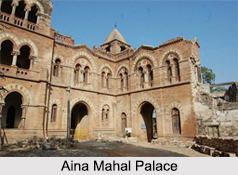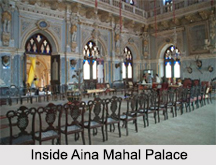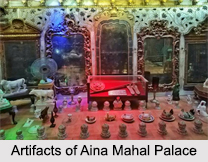 Aina Mahal is a palace situated in Bhuj district of Gujarat, which was built in the 18th century. The palace was built by Rao Lakhpatji of Kutch State around 1750. It was designed by Ram Singh Malam with the blend of both local and European style of architecture with glasses, mirrors and tiles. Aina Mahal has been converted into a museum in 1977 exhibiting European collection including clocks, wares, mechanical toys, paintings and pictures.
Aina Mahal is a palace situated in Bhuj district of Gujarat, which was built in the 18th century. The palace was built by Rao Lakhpatji of Kutch State around 1750. It was designed by Ram Singh Malam with the blend of both local and European style of architecture with glasses, mirrors and tiles. Aina Mahal has been converted into a museum in 1977 exhibiting European collection including clocks, wares, mechanical toys, paintings and pictures.
History of Aina Mahal
The architecture of the palace lived in Europe for 18 years, which helped him to obtain the skills of European craft and architecture. The entire construction of the palace costed almost the state revenue of three years in that period. The palace was damaged in the 2001 Gujarat earthquake; later a part of the palace was restored and now it houses the Aina Mahal Trust Museum.
 Architecture of Aina Mahal
Architecture of Aina Mahal
Aina Mahal palace is a two storied mansion built with stones and designed by stone carvings and wood fretwork. The design of the palace is in Indian style and the decoration is European. The palace floors are made with blue delftware tiles and the marble walls of the palace are decorated with mirrors which are separated by gilded frames. These walls are adorned with fitted shelves on which glass and ceramics were displayed. The rooms were illuminated by hanging candelabra and chandeliers with shade of Venetian glass. The pillars and roofs were ornamented with gold. The space between pillars and walls are filled with triangular mirror compartments. The two floors of Aina Mahal palace are consisted of several halls or darbar rooms, which were used for different purposes. The halls are described in brief below:
First Floor: The first floor of the Aina Mahal palace is consisted of two mahals named Hira Mahal and Fuvara Mahal. Hira Mahal or the royal bedchamber is located in the centre of the first floor of the palace. It has a bed of Maharao Lakhpatji. The floors and walls of Hira Mahal are covered in cloth panels of "Kutchi silk saari" embroidery and the ceilings, pillars and doors are covered in mirror-work and wood-carvings. The Fuvara Mahal or Pleasure Hall, located adjacent to the Hira Mahal, is a chamber with a pleasure pool; there are mountains in the pool area. The pool is encompassed by pillars, which are lined by corridor. These pillars were decorated with Chinese carvings. There is a throne in the center of the platform, which was surrounded by water sprays and fanned from above. Fuvara Mahal was used for courts and pleasures by Maharao. The chamber was illuminated by hanging candelabra. There are some glass paintings with Chinese influences in the mahal; they were brought in Kutch in 18th century by merchants.
 Second Floor: The courts were held in the second floor. In the ante-chamber, there are Mughal farmans (royal decrees) issued between 1617 and 1658 by Shah Jahan, Jahangir and Dara Shikoh. They were mostly addressed to Rao Tamachi. The Darbar Hall in the second floor has a silver throne with the wooden chairs of 19th century on both sides. There is also a Marriage Hall, which was built for Maharao Khengarji III in the year 1884. Various weapons are exhibited on the walls and a perfume sprayer is placed in the centre of the hall.
Second Floor: The courts were held in the second floor. In the ante-chamber, there are Mughal farmans (royal decrees) issued between 1617 and 1658 by Shah Jahan, Jahangir and Dara Shikoh. They were mostly addressed to Rao Tamachi. The Darbar Hall in the second floor has a silver throne with the wooden chairs of 19th century on both sides. There is also a Marriage Hall, which was built for Maharao Khengarji III in the year 1884. Various weapons are exhibited on the walls and a perfume sprayer is placed in the centre of the hall.
Valuable Artifacts of Aina Mahal Trust Museum
Aina Mahal Trust Museum houses several valuable artifacts which anticipate the story of the Kutch rulers. Among several articles, some have special significance. For example, one of the doors of the palace, decorated with ivory and gold, was made by a carpenter named Madho in 1798 during the reign of Pragmalji I. The collection of the museum also includes the Mahi Maratib (a golden fish), which was gifted to Maharao Lakhpatji by Mughal Emperor during his visit to Delhi. There are artistic horoscopes of the rulers, which are drawn in the local Kamangari painting style by the astrologers of each ruler. It includes a 38.7 meters long horoscope of Rao Pragmalji II; it dated 1839 and is believed to be the longest horoscope in the world.



















